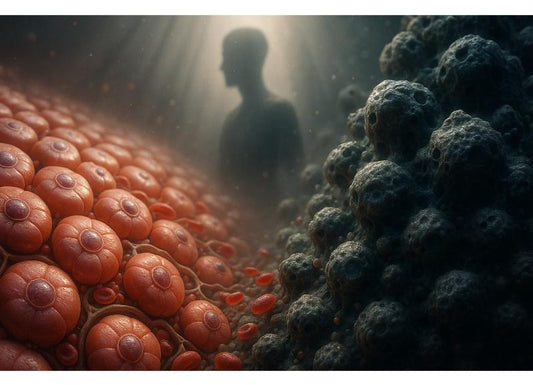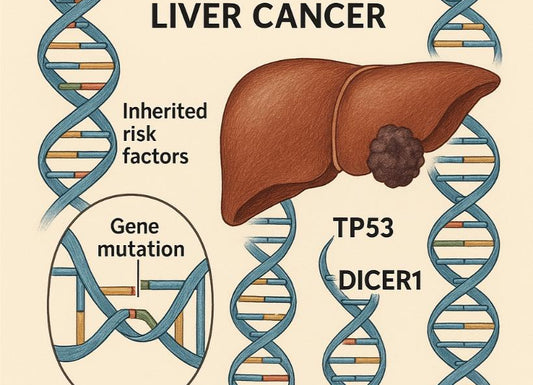Is Cirrhosis of the Liver Cancer?
 Written By
Blen Shumiye, MD
Written By
Blen Shumiye, MD

When someone is diagnosed with cirrhosis of the liver, one of the most common concerns is whether it means liver cancer. While cirrhosis and liver cancer are closely related, they are not the same condition. Cirrhosis refers to severe scarring of the liver, whereas liver cancer is the uncontrolled growth of abnormal cells in the liver.
Understanding the difference and how one can lead to the other is key to early detection, prevention, and effective treatment.
What Is Cirrhosis of the Liver?
Cirrhosis is the result of long-term liver damage caused by conditions such as chronic hepatitis, fatty liver disease, or excessive alcohol use. Over time, healthy liver cells are replaced by scar tissue, which interferes with blood flow and normal liver function.
The liver becomes hardened and unable to filter toxins, produce bile, or store nutrients properly. While cirrhosis is serious, it is not cancer, though it does increase the risk of developing liver cancer.
Common causes of cirrhosis include:
-
Chronic hepatitis B or C infections.
-
Nonalcoholic fatty liver disease (NAFLD) or nonalcoholic steatohepatitis (NASH).
-
Long-term alcohol use.
-
Autoimmune or genetic liver conditions.
What Is Liver Cancer?
Liver cancer occurs when liver cells grow uncontrollably, forming tumors. The most common type is hepatocellular carcinoma (HCC), which usually develops in people who already have cirrhosis or chronic liver inflammation.
Other, less common types include cholangiocarcinoma (bile duct cancer) and angiosarcoma (blood vessel cancer).
How Cirrhosis Increases the Risk of Liver Cancer
Cirrhosis itself is not cancer, but it creates an environment where cancer is more likely to develop.
Here’s how:
-
Chronic inflammation: Continuous liver damage triggers cell repair, which increases the likelihood of DNA errors.
-
Scar tissue: Fibrosis disrupts normal liver structure, trapping damaged cells and encouraging abnormal growth.
-
Reduced immunity: The liver’s weakened immune surveillance allows cancerous cells to multiply unchecked.
According to studies, up to 80% of people who develop liver cancer already have cirrhosis. This is why regular monitoring and early detection are critical for cirrhosis patients.
Cirrhosis vs. Liver Cancer: Key Differences
|
Feature |
Cirrhosis |
Liver Cancer |
|
Definition |
Chronic scarring and liver damage |
Uncontrolled growth of malignant liver cells |
|
Cause |
Chronic injury (alcohol, hepatitis, fatty liver) |
Genetic mutations in liver cells, often due to cirrhosis |
|
Nature |
Noncancerous (but progressive) |
Cancerous and potentially life-threatening |
|
Treatment Focus |
Managing cause and slowing progression |
Removing or destroying tumors, sometimes with transplant |
|
Reversibility |
Damage is permanent but manageable |
Requires cancer-specific therapy |
Curious about outcomes? Learn about liver cancer survival rates.
Symptoms: Overlapping but Distinct

Because both conditions affect the liver, they share many symptoms. However, cancer often causes more severe or sudden changes.
Symptoms common to both:
-
Fatigue and weakness.
-
Jaundice (yellowing of the skin and eyes).
-
Abdominal swelling (ascites).
-
Weight loss and poor appetite.
Symptoms more specific to liver cancer:
-
Sharp or persistent pain in the upper right abdomen.
-
A hard lump or mass under the ribs.
-
Rapid deterioration in liver function.
-
Unexplained fever.
Diagnosing Cirrhosis and Liver Cancer

If cirrhosis is suspected or already diagnosed, doctors use regular screenings to catch cancer early.
Common diagnostic tests include:
-
Blood tests: Liver function panels, AFP (alpha-fetoprotein) tumor marker.
-
Imaging scans: Ultrasound, MRI, or CT scans to detect tumors or nodules.
-
Liver biopsy: Confirms the presence of cancer cells if a mass is found.
Early-stage liver cancer is often treatable if detected before the tumor spreads.
Also, try our at-home liver test for comprehensive health monitoring and get results quickly.
Can Cirrhosis Turn Into Cancer?
Cirrhosis itself does not “turn into” cancer, but the chronic damage and cell regeneration that occur in cirrhosis increase the likelihood of malignant transformation.
In patients with cirrhosis:
-
The risk of developing liver cancer increases by 1–4% each year.
-
Regular monitoring (every 6 months) using imaging and blood tests significantly improves survival rates.
Here's how to tell if your liver is struggling and when to act.
Treatment Options
For Cirrhosis:
-
Treat the underlying cause (hepatitis therapy, alcohol cessation, weight loss).
-
Manage symptoms and prevent complications.
-
Maintain a liver-healthy diet and avoid toxins.
For Liver Cancer:
-
Surgical removal of small tumors.
-
Ablation or embolization to destroy or cut off tumor blood supply.
-
Targeted therapies or immunotherapy.
-
Liver transplantation if cancer is confined and liver function is poor.
See our article on doctor-approved tips to reduce liver inflammation quickly.
Preventing Liver Cancer When You Have Cirrhosis

If you have cirrhosis, proactive care can lower your risk of liver cancer:
-
Quit alcohol completely.
-
Manage hepatitis infections through antiviral therapy.
-
Eat a balanced diet with plenty of fruits, vegetables, and lean proteins.
-
Avoid obesity and diabetes through exercise and diet control.
-
Get screened regularly (ultrasound and AFP blood test every 6 months).
Prognosis and Outlook
With proper treatment, people with cirrhosis can live for many years, especially if the underlying cause is controlled. If cancer develops, early detection greatly improves the chances of successful treatment.
Key takeaway: Cirrhosis is not liver cancer, but it creates the conditions for cancer to develop if left unchecked. Regular monitoring can make all the difference.
The Bottom Line
Cirrhosis of the liver is not cancer, but it’s one of the strongest risk factors for liver cancer. Both conditions require close medical supervision and lifestyle adjustments.
If you’ve been diagnosed with cirrhosis, regular screening and healthy habits can help you catch liver cancer early or prevent it altogether.
Want to check your liver function from home?
You can take an at-home liver and metabolic test through Ribbon Checkup and get results instantly.
Related sources
-
End Stage Liver Cirrhosis Patient–Symptoms, Survival, and Care Options
-
Is Liver Cancer Hereditary? Genetic Risks and Family History
References
admin. (2025, April 23). Understanding the Difference Between Liver Cancer and Cirrhosis - Kumaran Hospitals. Retrieved November 10, 2025, from Kumaran Hospitals website: https://kumaranhospitals.com/understanding-the-difference-between-liver-cancer-and-cirrhosis/health/
How. (2017, March 16). Cirrhosis of the Liver: What It Is, Symptom & Treatment. Retrieved November 10, 2025, from Cleveland Clinic website: https://my.clevelandclinic.org/health/diseases/15572-cirrhosis-of-the-liver
Liver cancer - Symptoms and causes. (2025). Retrieved November 10, 2025, from Mayo Clinic website: https://www.mayoclinic.org/diseases-conditions/liver-cancer/symptoms-causes/syc-20353659
Liver disease vs. liver cancer: What’s the difference and is there a connection? (2024, October 31). Retrieved November 10, 2025, from Prevent Cancer Foundation website: https://preventcancer.org/article/liver-disease-vs-liver-cancer/
Pinter, M., Trauner, M., Peck-Radosavljevic, M., & Wolfgang Sieghart. (2016). Cancer and liver cirrhosis: implications on prognosis and management. ESMO Open, 1(2), e000042–e000042. https://doi.org/10.1136/esmoopen-2016-000042

Dr. Blen is a seasoned medical writer and General Practitioner with over five years of clinical experience. She blends deep medical expertise with a gift for clear, compassionate communication to create evidence-based content that informs and empowers. Her work spans clinical research, patient education, and health journalism, establishing her as a trusted voice in both professional and public health spheres.



